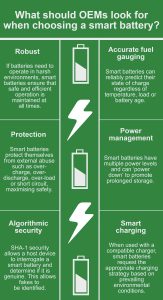
Smart battery guide will reduce costly design errors
By Accutronics Ltd.
Electronics Power Supply / Management Engineering Supply Chain battery battery cells battery engineering battery in design battery sourcing powerProfessional battery manufacturer Accutronics Ltd., Staffordshire UK, has published an infographic providing guidelines for original equipment manufacturers (OEMs) on what should be considered when specifying a rechargeable smart battery to power their next product. The infographic highlights the importance of considering batteries at the earliest possible stage in the development process. 
Accutronics believes the most common and most costly mistake a design engineer can make when choosing a power source is leaving specification until it’s too late. With smart batteries becoming increasingly common in industries such as medical and military, the demands placed on them are also becoming increasingly challenging. The infographic can be downloaded here.
The infographic highlights the key features a design engineer or purchasing team should look for in a smart battery, including fuel gauging which can provide accurate state of charge prediction regardless of temperature, load and age. An accurate fuel gauge provides confidence whilst an inaccurate gauge can result in ‘runtime anxiety’ with the user constantly in fear that their device will run out of power. If the device is being used in a medical or mission-critical military application then the premature depletion of battery power could have severe implications.
Smart power management ensures the battery only receives charge when it is required
Other essential features include protection circuitry which prevents the battery cells from being over-charged, over-discharged, or operated at extreme temperatures. Smart power management ensures the battery only receives charge when it is required – this enhances both the life and safety of the battery. The ability for the battery to operate under differing power modes also allows it to hibernate when it is stored, maximizing the shelf-life of batteries which may be in the supply chain for prolonged periods.
“As the complexity of battery powered applications increases, OEM buyers need to ask themselves how fit for purpose their current design methodology is,” explained Michele Windsor, global marketing manager for Accutronics and Ultralife. “By choosing a smart battery, OEMs can rest assured that their device will continue to deliver optimum performance in a variety of applications. Whether it’s the reliability and security demanded in the medical industry, or the extreme temperatures and harsh conditions faced in military and defense use, smart batteries can step up to any environment.
“Because smart batteries are used in many life-critical situations, we’re also concerned about the rise of counterfeiting in the battery industry. Counterfeit batteries may be built using inferior battery cells and often lack the critical protection electronics which are required to make them operate safely. Also, a lack of quality control during manufacture, or forged regulatory certification means that fake batteries could prove costly for many OEMs.
“The infographic also highlights the importance of selecting a battery with built in digital algorithmic security, which can be used by a host device or charger to ensure that that the installed battery is the genuine article.”
